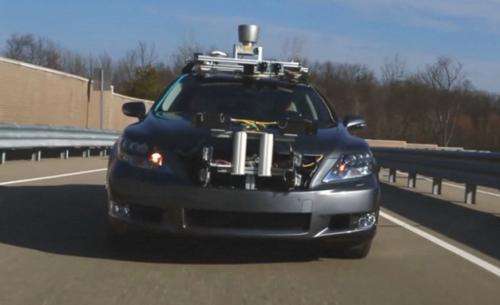(Phys.org)—While the Consumer Electronics Show in Las Vegas starting January 8 will be full of mobile-computing gadgetry next week, autonomous driving demonstrations will also capture visitors' attention, and will raise awareness that autonomous driving technologies are to shape the future of road transport, sooner than later. Toyota has delivered a video clip that shows a self-drive prototype with gear on its grille and on its roof, ahead of CES.
The car is a 2013 Lexus LS carrying equipment that includes on-board radar and video cameras to monitor the road and the driver. Toyota's driverless features involve car-to-car and car-to-infrastructure technologies.
The cameras and radar equipment can detect traffic signals, lane lines and other vehicles. The technology aims to prevent crashes—a Toyota spokesman said zero collisions are the goal. The car can be driver-assisted or completely self-driving. When a driver is at the wheel, Toyota's technology could boost safety by detecting obstacles or alerting the driver if the driver is falling asleep.
Lexus advanced active safety research vehicle
Toyota refers to its "Intelligent Transport Systems" technology. As part of the ITS concept, beacons detect the positions of pedestrians and obstacles and relay information to the vehicle, on whether a traffic light is green or red. Toyota plans to say more about its autonomous driving technology at a press conference at CES. The vehicle will be shown at the Lexus display.
Toyota's announcement indicates how car-makers want to follow the limelight that was already captured by Google in its development of a fully autonomous vehicle tested on public roads. Last year, the state of Nevada granted Google a license to test its self-driving Toyota Prius on its roads. In addition to Toyota, the CES event will include a demonstration by Audi on its autonomous driving developments, including a feature that allows a car to find a parking space and park itself.
Last year, Volvo tested a self-drive convoy on a Spanish motorway, completing a 125-mile trip, in the first public test of such convoy vehicles.
At the Continental Automotive Group, system suppliers, Dr. Elmar Degenhart, chairman of the executive board, said that it is clear that mobility in the future will include automated driving. As a system supplier, he said, the company is positioned to launch solutions for partially automated systems for customers by 2016.
A report from KPMG and the Center for Automotive Research similarly said that driverless cars are coming sooner than consumers may think. "The next generation of driver-assist systems will likely offer greater vehicle autonomy at lower speeds and may reduce the incidence of low-impact crashes. For example, traffic jam assist solutions work at speeds up to 37 mph."
While car manufacturers working on driverless features emphasize the upside of safety and a reduction in collisions, Google's Larry Page recently brought up another reason why driverless cars may be a beneficial development in the future of cars. He brought up economics. "Do you really want to use all your concrete and steel to build parking lots? It seems pretty stupid. If we have automated cars, or even if we have some fraction of automated cars, we'll save hundreds of millions of dollars on parking," he told Fortune. In his suggested scenario, the autonomous car can drop the driver off to the office, then park itself. Later, the worker's smartphone detects when the driver is leaving the office and proceeds immediately to pick up the driver.
More information: www.kpmg.com/US/en/IssuesAndIn … -next-revolution.pdf
© 2013 Phys.org





















